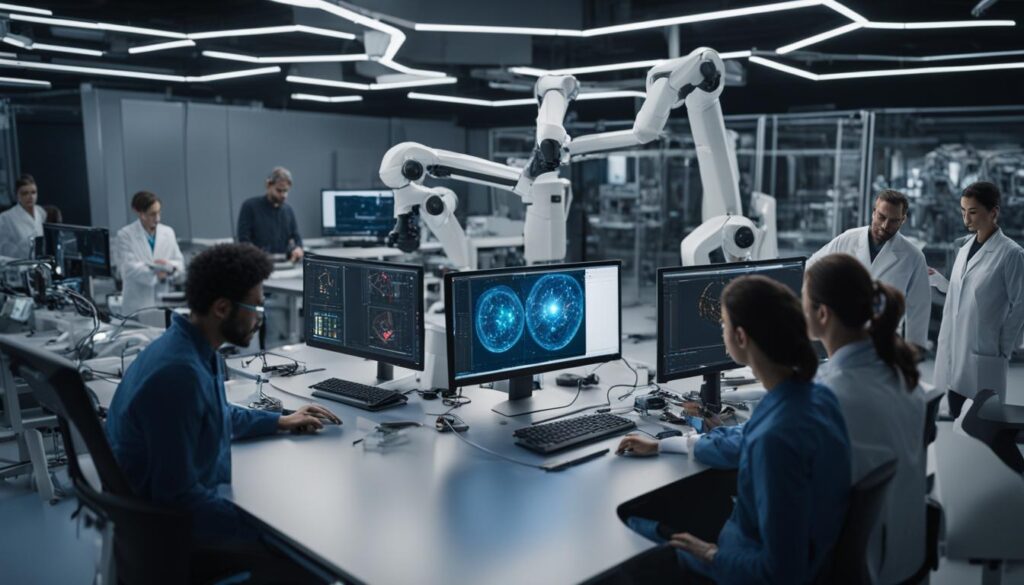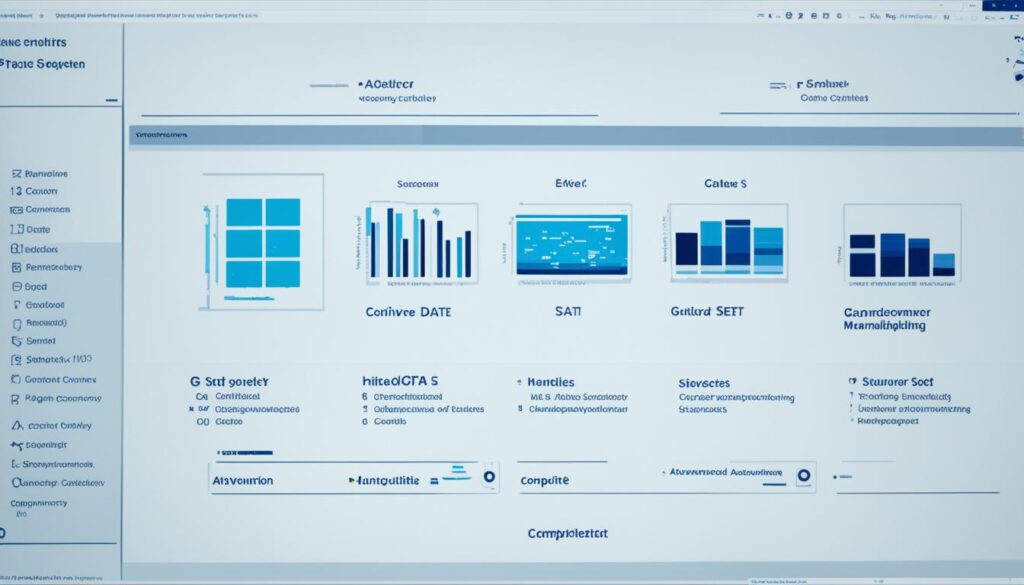Welcome to our comprehensive guide on generative artificial intelligence (AI). In this article, we will explore what generative AI is, its applications, and the underlying technology that powers it. With the advancements in AI generation techniques, generative models have the ability to create new and unique content, revolutionizing various industries.
Generative AI, a form of machine learning, allows computers to generate new content such as music, art, and virtual worlds. It goes beyond traditional AI approaches by creating original and creative outputs. This technology has found practical applications in fields like product design, business optimization, and much more.
A popular tool in the field of generative AI is ChatGPT, developed by OpenAI. ChatGPT can generate answers to questions and has been used to create computer code, essays, poems, and jokes. Generative AI models like ChatGPT are built using large language models that are trained on vast amounts of data, enabling them to solve a wide range of problems.
However, the distinction between generative AI and other forms of AI can sometimes be blurry. While generative AI holds incredible potential, the full extent and risks associated with it are still being explored.
Key Takeaways:
- Generative AI allows computers to generate new content, such as music, art, and virtual worlds.
- ChatGPT is a popular generative AI tool developed by OpenAI that can generate answers to questions and create various types of content.
- Generative AI models are built using large language models and can solve a wide range of problems.
- The distinction between generative AI and other forms of AI can sometimes be unclear.
- The full potential and risks associated with generative AI are still being explored.
The Difference between Machine Learning and Artificial Intelligence
Artificial intelligence (AI) and machine learning (ML) are intricately related but distinct fields within the realm of computer science. Understanding the difference between these two concepts is essential for anyone exploring the fascinating world of AI and ML.
Artificial intelligence involves the practice of developing computer systems capable of performing tasks that typically require human intelligence. It encompasses a broad range of techniques and approaches aimed at enabling machines to mimic human behaviors, reasoning, and problem-solving abilities.
Machine learning, on the other hand, is a subfield of AI that focuses on developing models and algorithms capable of automatically learning patterns and making predictions from data, without explicit programming or human direction. ML models analyze vast amounts of data to identify trends, classify patterns, and make informed decisions.
In simpler terms, AI is the overarching concept that aims to create intelligent machines, while machine learning is a tool or technique used within AI to teach computers how to learn from data and improve their performance over time.
Machine learning models come in various forms and serve different purposes. They can be broadly classified into two main categories:
- Predictive models: These models learn from historical data to make predictions or classifications. They identify patterns in the data and use them to make informed decisions about new, unseen data. For example, a predictive ML model can analyze customer behavior data to predict whether a customer is likely to churn or make a purchase.
- Generative AI models: Unlike predictive models, generative AI models go beyond classification and have the ability to create entirely new content. They generate new data based on what they have learned. For instance, a generative language model can generate realistic text passages, like poems, stories, or even computer code, by learning patterns from existing examples.
Machine learning models have evolved significantly over the years. Initially, classical statistical techniques formed the foundation of early ML models. However, with advancements in computational power and the availability of large datasets, more complex and powerful ML models have emerged. Deep learning, a subset of ML inspired by the structure and function of the human brain, has gained immense popularity due to its ability to process and understand complex data.
| Machine Learning Models | Artificial Intelligence Models |
|---|---|
| Supervised Learning Models | Rule-based Systems |
| Unsupervised Learning Models | Natural Language Processing |
| Reinforcement Learning Models | Computer Vision Systems |
Generative AI models fall under the broader category of machine learning. They demonstrate the incredible potential of ML techniques by enabling machines to not only identify patterns but also to create new and original content.
In the next section, we will explore the main types of machine learning models and their applications across different industries.
The Main Types of Machine Learning Models
Machine learning models have evolved over time, starting from classical statistical techniques to more advanced models. In the past, machine learning predominantly focused on predictive models that observed and classified patterns in content. However, with the emergence of generative AI, the landscape has shifted to include the creation of new content on-demand.
One notable example of generative AI is ChatGPT, a text-based machine learning model developed by OpenAI. ChatGPT has transitioned from supervised learning, where humans labeled inputs, to self-supervised learning. This innovative approach involves training models on massive amounts of text data, enabling them to generate predictions with improved accuracy and the ability to produce contextually relevant and coherent text.
Generative AI models open up new possibilities by allowing computers to go beyond classification and actively generate unique content. This evolution in machine learning capabilities offers exciting opportunities for various industries and applications.
Building a Generative AI Model
Building a generative AI model is a complex task that requires significant resources and expertise. Companies like OpenAI, DeepMind, and Meta have developed some of the most advanced generative AI models in the industry.
Training an AI model on a massive dataset, such as the internet, can be expensive and time-consuming. For example, OpenAI’s GPT-3, one of the most powerful generative AI models, was trained on an enormous 45 terabytes of text data, costing several million dollars.
Building generative AI models involves more than just talent; it also requires access to substantial computational power and funding. These models undergo extensive AI model training processes, where they learn from vast amounts of data to generate coherent and contextually relevant content.
Companies like OpenAI, DeepMind, and Meta have invested heavily in the development of generative AI models, pushing the boundaries of what is possible in AI research and development.
Resources Required for Building Generative AI Models
Building generative AI models requires a range of resources, including:
- High-performance computing infrastructure to handle the computationally intensive training process
- Access to large-scale datasets for model training
- A team of experts in AI research and machine learning
- Funding to support the costs of data acquisition, infrastructure, and research
These resources are essential to ensure the successful development and deployment of generative AI models.

“Building generative AI models involves more than just talent; it also requires access to substantial computational power and funding.”
– OpenAI Research Scientist
Output of Generative AI Models
Generative AI models have the remarkable ability to generate a wide range of content, including text, images, music, and business simulations. These models have the potential to create content that closely resembles human-generated content, providing realistic and human-like outputs. The quality of the output is influenced by the capabilities of the generative AI model and how well it matches the input. When the model is well-trained and aligned with the desired output, the generated content can be indistinguishable from content created by humans.
For instance, a generative AI model can produce a piece of writing that is coherent, engaging, and contextually relevant. It can generate creative marketing copy, persuasive essays, or informative articles. The model learns from vast amounts of data in order to mimic the writing style and produce high-quality text. Similarly, generative AI models can generate realistic images, compose original music, or simulate business scenarios.
“Generative AI models can create content that is virtually indistinguishable from human-generated content. The outputs can capture the essence of human creativity, delighting audiences and providing valuable assets for various industries.”
However, it is important to recognize that generative AI models have limitations. In some cases, the outputs may be inaccurate, inappropriate, or fail to meet the desired expectations. The models are trained based on the data they have been exposed to, which means they may unintentionally incorporate biases or produce content that is misleading. Additionally, generative AI models are susceptible to generating gibberish or nonsensical output if the input is poorly understood or ambiguous.
Despite these limitations, generative AI outputs are carefully calibrated combinations of the data used to train the models. The incorporation of randomness adds to the lifelike appearance of the content. By leveraging generative AI, businesses can benefit from the generation of realistic and human-like content that can enhance their creative processes, augment their marketing efforts, and provide unique interactive experiences to their users.
Realistic and Human-like Content: Impact in the Digital World
The ability of generative AI models to generate realistic and human-like content has transformative potential across various sectors. It allows businesses to efficiently create high-quality content at scale, reducing the need for extensive human involvement. Furthermore, generative AI technology empowers individuals to explore their creativity, assisting them in producing original pieces without requiring specialized skills or knowledge.
Throughout the digital landscape, generative AI has applications in fields such as entertainment, marketing, and education. Chatbots and virtual assistants powered by generative AI can engage users in natural and human-like conversations, providing personalized recommendations, and delivering immersive experiences. Additionally, generative AI models can assist in generating synthetic data, augmenting machine learning training, and improving algorithms’ performance.
In conclusion, generative AI models have the capacity to generate diverse and realistic content, offering businesses and individuals novel possibilities for creativity, efficiency, and innovation. While being aware of their limitations, organizations can harness the power of generative AI to create compelling content that resonates with audiences, and drive meaningful interactions in the digital age.
Applications of Generative AI Models
Generative AI models have become increasingly valuable across various industries, offering a wide range of applications and opportunities. Let’s explore some of the key areas where these models are making a significant impact.
Generative AI in Different Industries
Generative AI is revolutionizing industries by providing advanced capabilities in content generation and automation. Here are a few examples:
- The IT industry is leveraging generative AI models to create code snippets, generate test data, and provide intelligent suggestions for optimizing software development processes. These models enhance productivity and assist developers in writing high-quality code efficiently.
- Businesses are utilizing generative AI models to generate marketing copy, personalize customer communications, and create engaging content. This technology helps companies reach their target audience effectively and deliver tailored messaging.
- AI-generated writing has found significant applications in journalism, content creation, and storytelling. By using generative AI models, writers and journalists can automate the creation of articles, blogs, and reports, saving time and resources while producing high-quality content.
- Generative AI models are also transforming data generation for training intelligent systems. Synthetic data generation techniques enable the creation of diverse and realistic datasets, which are crucial for training computer vision models and AI systems to recognize objects and make accurate predictions.
Business Applications of Generative AI
The applications of generative AI extend beyond content generation. It offers numerous opportunities for businesses to innovate and optimize their operations. Some key business applications include:
“Generative AI enables companies to automate repetitive tasks, such as report generation, data analysis, and customer support. By leveraging these models, businesses can streamline their processes, reduce costs, and enhance overall efficiency.”
Moreover, generative AI can be employed in decision support systems, enabling businesses to make data-driven and contextually relevant decisions. These models can analyze complex data sets, identify patterns, and provide insights that aid in strategic decision-making.
Synthetic Data Generation
One of the most significant applications of generative AI is synthetic data generation. This technique involves creating artificial datasets that mimic real-world data distributions. Synthetic data can be used to overcome limitations in data availability and privacy concerns, especially in sectors like healthcare and finance. By using generative AI models, organizations can generate synthetic data that represents the characteristics of real data, making it a valuable resource for training and testing machine learning models.
The Role of Generative AI in Transforming Industries
Generative AI models are reshaping industries and presenting new possibilities for innovation. They enable businesses to automate processes, create personalized content, and generate data for training intelligent systems. As organizations embrace generative AI technology, it will continue to drive advancements and transform various sectors.

| Industry | Application |
|---|---|
| IT | Code generation, test data generation, software optimization |
| Marketing | Marketing copy generation, customer communication personalization |
| Writing | AI-generated writing, content automation, journalism |
| AI Development | Synthetic data generation, computer vision training |
| Decision Making | Decision support systems, data analysis, insights |
The History of Generative AI
Generative AI has a rich history that spans over 70 years, evolving alongside advancements in artificial intelligence (AI) and machine learning. The journey started in the 1950s with early text analytics and rule-based systems, where researchers focused on analyzing and extracting meaning from textual data. These systems laid the foundation for the development of more sophisticated AI techniques in the future.
In the 1980s, natural language processing (NLP) techniques emerged, allowing computers to understand and process human language more effectively. NLP paved the way for advancements in generative AI, enabling the creation of algorithms that could generate human-like text based on patterns and rules.
However, it was the advent of machine learning in the 2000s that truly revolutionized the field of generative AI. Machine learning algorithms, fueled by large datasets and powerful computational resources, became capable of learning from vast amounts of information and generating content that was increasingly coherent and contextually relevant.
With the development of GPT-3 (Generative Pre-trained Transformer 3) by OpenAI in the 2020s, generative AI reached new heights. GPT-3 demonstrated unparalleled language generation capabilities, producing highly realistic and human-like text that was indistinguishable from content written by humans. It marked a significant breakthrough in generative AI and opened up a world of possibilities for its applications.
In recent years, generative AI models have continued to advance through the use of deep learning architectures and the availability of massive datasets. These models can now generate not only text but also other forms of content such as images, music, and even business simulations.
To visualize the evolution of generative AI over the years, here is a table showcasing the key milestones:
| Decade | Development |
|---|---|
| 1950s | Early text analytics and rule-based systems |
| 1980s | Advancements in natural language processing (NLP) |
| 2000s | Rise of machine learning in generative AI |
| 2020s | Development of GPT-3 and breakthrough in language generation |
The history of generative AI showcases the continuous evolution of AI technology and its increasing ability to generate content that rivals human creativity. As researchers and developers continue to push the boundaries of generative AI, we can expect even more remarkable advancements in the future.
Conclusion
Generative AI is a powerful technology that has the potential to revolutionize industries and enhance human capabilities. With its ability to generate diverse and realistic content across various mediums, from text to images and audio, generative AI opens up new possibilities for businesses and individuals alike. While there are limitations and risks associated with generative AI models, the opportunities they present are vast.
The field of generative AI is continuously evolving, driven by ongoing research and advancements in models like GPT-3 and its successors. These developments pave the way for the future of generative AI, which holds promise for applications in fabrication, general intelligence, and creative content generation. Embracing generative AI can lead to increased innovation and transformation in the digital age.
As generative AI continues to progress, it is essential to navigate the potential risks responsibly. Adhering to ethical guidelines and prioritizing user safety and privacy are crucial factors in harnessing the power of generative AI. With careful consideration and responsible implementation, generative AI can unlock the full extent of its capabilities and shape a brighter future.
FAQ
What is generative AI?
Generative AI is a form of machine learning that allows computers to generate new content such as music, art, and virtual worlds.
How does generative AI differ from other forms of AI?
Generative AI models go beyond classification and have the ability to create new content, while other forms of AI focus on mimicking human intelligence or making predictions based on patterns.
What are the practical applications of generative AI?
Generative AI has practical applications in various industries, including product design, business optimization, generating writing or code, marketing copy, and synthetic data generation.
What are the main types of machine learning models?
The main types of machine learning models are predictive models, which classify patterns in content, and generative AI models, which create new content without human direction.
How are generative AI models built?
Building a generative AI model requires significant resources and expertise. Companies like OpenAI, DeepMind, and Meta have developed some of the most advanced generative AI models.
What can generative AI models produce?
Generative AI models can produce a wide range of content, including text, images, music, and business simulations. The quality of the output depends on the model’s capabilities and the input.
What is the history of generative AI?
Generative AI has a history spanning over 70 years, starting with early text analytics and rule-based systems. The breakthrough came with the development of GPT-3 in the 2020s, which demonstrated the ability to generate highly coherent and contextually relevant text.
What is the future of generative AI?
Generative AI holds promise for applications in fabrication, general intelligence, and creative content generation. Ongoing research and advancements in models like GPT-3 and its successors will continue to drive the field forward.








